The Dutchman System is one of the best ways to handle your mainsail while hoisting or lowering. To drop the main you feather the mainsail or go head to wind, then ease the main halyard reasonably fast. If you are navigating a crowded harbor, you can let the halyard run and clean up later.
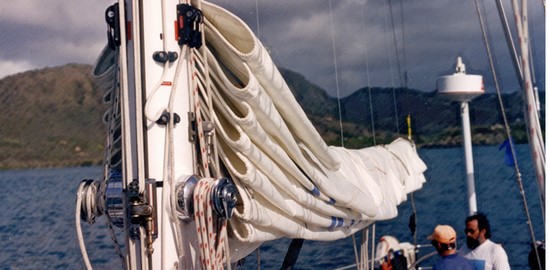
This article describes the function of the Dutchman main sail flaking system. We look at the important features that ensure proper operation, plus potential hazards to look out for.
Video Dutchman Demonstration
Dutchman system description
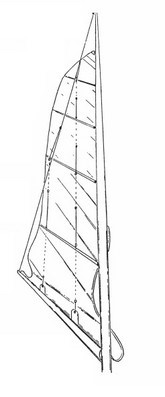
The Dutchman system invented by Martin van Breems is a main sail flaking system that works like a blind. You know the blinds in your windows, that weave in and out of the vertical line. When you pull up the blind the pleats neatly stack flat.
Take a look at your main when it is properly flaked on the boom. Now imagine 2 control lines (3 for larger boats) leading from the boom and going through the main up to a topping lift. These lines control the main sail during hoisting and lowering.
The system is quite simple in its design but does require proper installation and setup. To use a Dutchman System you will need slides/slugs or batten cars on your mainsail.
A better Dutchman system is achieved with a special track and car/slide system, like Tides Marines strong track. The track and car system enables the sides to move up and down easier with less jamming
Dutchman System Features
(how it works)
The major components of the Dutchman system, consist of a topping lift and vertical control lines weaved in and out of the main sail.
When the mainsail is lowered, the boom drops until the topping lift takes up its weight. When this happens the vertical Dutchman filament lines should also become tight. If they do come tight at the same time as the topping lift you need to adjust them ( see installation).
When the mainsail is hoisted, the boom rises and hence the topping lift and the Dutchman lines go slack at the same time. This way the lines do not interfere with the set of the sail as it fills with wind.
Dutchman system options
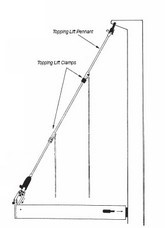
System A for boats with a halyard-style topping lift.
System B with a pennant as a continuous loop of line.
The A system is best and it has two options depending on your boats setup. If your boat has a topping lift with a sheave at the masthead and runs to the deck this is best. If you have a topping lift like this its easy to setup a Dutchman system.
If not you will need to install a Topping Lift and the simplest method is to take a line fix it the the mast head and tie it to the end of the boom. This is you topping lift
| Components of the Dutchman system. | ||
| Dutchman Kit | kit contains; Mono filament control line, Topping Lift Kits & Parts, tabs & discs, and mono clamp for pocket. | |
| Topping lift | You need a dedicated halyard for a topping lift | If you do not have a Topping lift you can add a single line one |
| Track or Luff Groove | Tides strong Marine track | Not a requirement but this simple track added to your mast, makes the sail slide up and down easily. |
| Mainsail Slides | Ronstan Ball Slider | An alternative to the metal slides, this ball slider works with a standard bolt rope mast track |
| Round Discs | Special chafe guards are added to the sail where the filament control line goes through the sail. | Included in kit |
| Sailmaker | Sail maker who have Dutchman experience | Discs and pockets need to be added to your sail |
| Battens | what batten system do you have | Full battens work best |
| Pockets | The sailmaker attaches pockets for the filament control lines at the foot of the sail | The clamps for the line are included in Kit |
A system when you do not have a Topping Lift
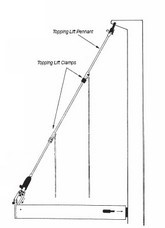
You can make an A system without a dedicated sheave, but will need a bosuns chair to go up and fix a topping lift permanently to the mast head crane. I have done this many times so it works fine.
The topping lift can be a line or a PVC coated wire with eyes top and bottom. The top can be shackled to a hole you drill in the masthead crane. The bottom can be a light tackle system or a line you can tie off and can adjust. The topping lift is not that structural as its main job is just to hold the weight of the boom.
The filament control lines need to be vertical for the system to work. If they are not you will have to adjust the clamps on the topping lift, which will require going aloft.
Dutchman System Installation
There are 3 stages in installation;
- Modifications to the sail
- Making and installing topping lift
- Setting up the system on the boom
Mainsail modification

Getting a main sail ready for a Dutchman system involves adding the discs, for the vertical lines to pass through, then adding the pockets at the bottom (foot) of the sail.
You can add these pockets to a main with a bolt rope foot, or a loose footed sail. A Bolt rope is better, but not a huge difference. If you have a footless bolt rope then you will need a fairly tight outhaul as the foot of the sail may get pulled up during hoisting.
You will need a sail maker to add grommets to the sail. Its important to have them in exactly the right place so the sail flakes properly. If you have sail slides and full length battens this will effect the layout and placements of the grommets. Consult a sail maker that has good experience with the Dutchman system and ask to see if they have one they can show you. Incorrect layouts will hinder performance. If the sail is laid out correctly and installed correctly, you will have a wonderful system.
Topping Lift Installation
If you decide on adding a topping lift, but do not have a spare sheave, you can attach a static topping lift to the masthead crane and then have a adjusting system at the boom end to control boom height.
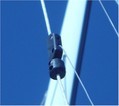
Once you have decided on the topping lift the next stage is to install the clamps. The clamps hold the filament lines to the topping lift.
The lower clamp shown here is to keep the filament clamp at the right height.
The A system can be worked with a dedicated topping lift halyard or a topping lift which can be added. The diagram to the left shows a dedicated topping lift halyard, which is shackled to the end of the boom and boom height can be controlled with the halyard.
Setting the system on the boom
Once we have the Mainsail modified and the Topping Lift is installed, we can complete the installation.
One of the most important details is to make sure the topping lift and vertical Dutchman filament lines become taught at the same time. Without this the sail will not flake properly. There are adjustable pockets on the bottom of the main sail that allow you to alter the vertical lines.
First set the topping lift. The boom when lowered should be held up by the Topping Lift. Next set the vertical lines so they are taught but not too tight they loosen the topping lift.
Operation
Go head to wind and let the sail down reasonably fast. My experience and that of others, is that if you let the sail down too slowly there is more of a chance the boat moves around destroying the flaking process.
The first few weeks or longer you will have to help the mainsail drop and flake. The reason is a new sail, at least new to the Dutchman system will not know where to fold / flake. If you make sure its well flaked when you leave the boat it will develop creases and a memory. One the main has developed this memory you should be in good shape. With a smooth running mast track, I have found let it rip and you will have a good flake.
Maintenance and winter storage

There are two ways to remove the Main sail for storage. Shown is an A system with a static topping lift , where the main was removed by pulling the vertical filament lines through the discs and pockets, to remove the sail.
Re installing the sail requires threading the filament lines back through the sail. Its a good idea to mark the discs “UP” on the top side of the disc so when you are rethreading the line you have it going back the same way as before.
The easiest way is with a dedicated topping lift halyard. Drop the halyard unshackle it and place the Dutchman lines on top of the flaked sail. The Dutchman lines can stay with the sail, as you pull it off the boom.
Dutchman v Lazy Jacks
Positives are: Ease of hoisting and dropping sail. In emergency situations you can almost “drop it and forget it”. If you do not have experienced crew this is a blessing. Lazy jacks can do the same but not as neatly or quickly. The main can get caught up in the lazy jack lines requiring some manual setting.
Negatives are: More costly than lazy jacks, fiddly to install and maybe tough on the sail in extreme conditions. Also the main cover needs modifying unless you have a dedicated topping lift and can lower the lines.
